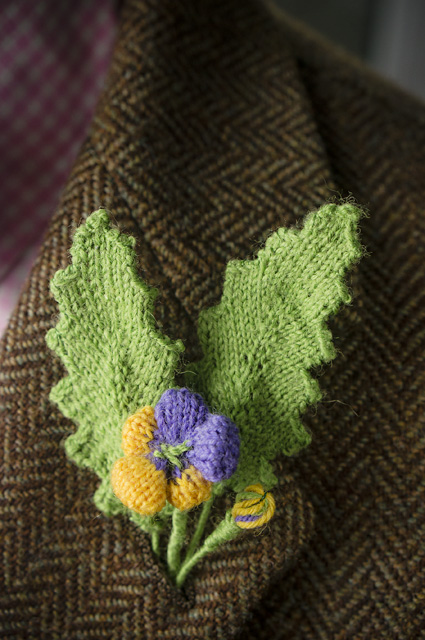

|
 by Franklin Habit, translated from The Floral Knitting Book; or, The Art of Knitting Imitations of Natural Flowers |
|
|
|
|
| SIZE |
One |
|
FINISHED MEASUREMENTS |
| Leaf: 6 inches from stem end to tip of leaf. Flower: Approximately 1 inch x 1 inch |
|
MATERIALS |
GAUGE PATTERN NOTES Make 1: Increase by casting on 1 st using the backward loop method described here. When you encounter this new st on the next row, knit it through the back. Herringbone Stitch: This is not the knitted herringbone, but the hand-sewing stitch as described here.
|
|
DIRECTIONS |
|
LEAF (make 2) Using long-tail method, and C1, CO 3 sts, leaving 10-inch tail. Work all rows of Leaf Chart. BO. Weave in ends. With wire snips, cut a length of florist wire about 20 inches long. Secure the thread near the base of the leaf with a few whip stitches. Leaving a wire "stem" approximately 5 inches long below the base, whip stitch the florist wire around WS edge of the leaf. Bend the wire as you proceed to conform to the contours of the edge. Upon reaching base again, knot thread securely to leaf and snip thread ends close. You should have an additional 4-5 inches of florist wire remaining. Twist these wire "stems" together tightly, using pliers if necessary. Wrap the CO tail tightly around the stem from the leaf to near the cut end, taking care the wires are completely covered. Secure with an overhand knot. Bend the wire end upwards to hold the knot in place. Trim off the excess yarn and wire ends. FLOWER
Turn work. Row 1: [K1, sl 1 purlwise] across. Turn work.
Weave in tail and cut off excess. Twist the ends of the wire together tightly below the base of the petal, and trim to a length of about five inches. Set aside. SMALL YELLOW PETAL (make 2).Using C3, CO 8 sts. Work in double-knitting as for Purple Petal. Work in C3 for 4 rows; then join C2 and work for 2 rows. Finish as Purple Petal, weaving loose in ends before turning petal inside-out. LARGE YELLOW PETAL Using C3, CO 12 sts. Work as for Purple Petal in C3 for 6 rows; then join C2 and work for 3 rows. Finish as Purple Petal, weaving loose in ends before turning petal inside-out. Work in double-knitting as for Purple Petal. Bring all petals together as shown in the photographs: the two purple at the top, the large yellow at the bottom, flanked by the two small yellow. Twist the wires of all the petals together firmly; this will likely require use of the pliers. FLOWER CENTER AND CALYX Using photograph at right as a guide, form the calyx by making one long, loose herringbone st into the back of every petal. Tie the two ends of the sewing yarn together with two knots at the base of the flower. Flower Stem. BUD
Clip one tail of the knot short. Use the other tail to wrap the stem of the bud as the stem of the leaf. FINISHING |
||||||||||||||||||||||||||||
| ABOUT THE DESIGNER |
| Franklin Habit (@franklinhabit on Twitter) is the proprietor of the popular knitting blog The Panopticon and author of It Itches: A Stash of Knitting Cartoons. His work appears regularly in major fiber arts publications, and he travels extensively to teach and speak on knitting-related topics.
After a boyhood of being forced into navy blue and mud brown sacks, he enthusiastically welcomes the return of men's fashions that are wholly unsuited to duck hunting, touch football, or tractor pulls. |
| Pattern & images © 2014. Franklin Habit. |